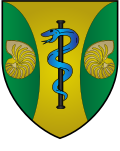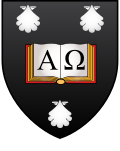| College | Arms | Blazon | Scarf | Blades |
|---|
| All Souls College |  | Or, a chevron between three cinquefoils gules. | | |
| Balliol College |  | Azure a lion rampant argent, crowned or, impaling gules, an orle argent. | |  |
| Brasenose College |  | Tierced in pale: (1) Argent, a chevron sable between three roses gules seeded or, barbed vert (for Smyth); (2) or, an escutcheon of the arms of the See of Lincoln (gules, two lions of England in pale or, on a chief azure Our Lady crowned seated on a tombstone issuant from the chief, in her dexter arm the Infant Jesus, in her sinister arm a sceptre, all or), ensigned with a mitre proper; (3) quarterly, first and fourth argent, a chevron between three bugle-horns stringed sable; second and third argent, a chevron between three crosses crosslet sable (for Sutton). [a] | |  |
| Christ Church |  | Sable, on a cross engrailed argent, a lion passant gules between four leopards' faces azure, on a chief or a rose of the third, seeded or, barbed vert, between two Cornish choughs proper. | |  |
| Corpus Christi College |  | Tierced per pale: (1) Azure, a pelican with wings endorsed vulning herself or; (2) Argent, thereon an escutcheon charged with the arms of the See of Winchester (i.e. gules, two keys addorsed in bend, the uppermost or, the other argent, a sword interposed between them in bend sinister of the third, pommel and hilt gold; the escutcheon ensigned with a mitre of the last); (3) Sable, a chevron or between three owls argent, on a chief of the second as many roses gules, seeded of the second, barbed vert. | |  |
| Exeter College |  | Argent, two bends nebuly within a bordure sable charged with eight pairs of keys, addorsed and interlaced in the rings, the wards upwards, or. | |  |
| Green Templeton College |  | Or between two flaunches vert on each a nautilus shell the aperture outwards or a rod of Aesculapius sable the serpent azure. | |  |
| Harris Manchester College |  | Gules, two Torches inflamed in saltire proper; on a Chief Argent, between Two Roses of a field barbed and seeded an open Book also proper. | | |
| Hertford College |  | Gules, a stag's head caboshed argent, attired, and between the attires a cross patty fitchy at the foot, or. | |  |
| Jesus College |  | Vert, three stags trippant argent attired or. | |  |
| Keble College |  | Argent, a chevron engrailed gules, on a chief azure three mullets pierced or. | |  |
| Kellogg College |  | Per pale indented argent and azure on the argent a chevron enhanced gules in base a book azure leaved argent on the azure an ear of wheat palewise or the whole within a bordure gules. | | 
Christ Church Boat Club [63] |
| Lady Margaret Hall |  | Or, on a chevron between in chief two talbots passant and in base a bell all azure, a portcullis of the field. | |  |
| Linacre College |  | Sable an open Book proper edged or bound gules the dexter page charged with the Greek letter alpha the sinister page charged with the Greek letter omega both sable the whole between three escallops argent. | |  |
| Lincoln College |  | Tierced per pale: (1) Barry of six argent and azure, in chief three lozenges gules, on the second bar of an argent a mullet pierced sable; (2) Argent, thereon an escutcheon of the arms of the See of Lincoln (i.e., Gules, two lions passant guardant or, on a chief azure the Blessed Virgin Mary ducally crowned seated on a throne issuant from the chief, on her dexter arm the infant Jesus and holding in her sinister hand a sceptre, all gold; the escutcheon ensigned with a mitre azure garnished and stringed or); (3) Vert, three stags trippant argent attired or. [b] | |  |
| Magdalen College |  | Lozengy ermine and sable, on a chief of the second three lilies argent slipped and seeded or. | |  |
| Mansfield College |  | Gules an open book proper inscribed DEUS LOCUTUS EST NOBIS IN FILIO in letters sable bound argent edged and clasped or between three cross crosslets or. | |  |
| Merton College |  | Or, three chevronels party per pale, the first and third azure and gules, the second gules and azure. | |  |
| New College |  | Argent, two chevronels sable between three roses gules, seeded or, barbed vert. | |  |
| Nuffield College |  | Ermine on a fesse or between in chief two roses gules barbed and seeded proper and in base a balance of the second three pears sable, and for crest on a wreath or and gules a demi bull gules armed and unguled or resting the sinister hoof on a winged wheel or. [c] | | |
| Oriel College |  | Gules, three lions passant guardant in pale or within a bordure engrailed argent. | |  |
| Pembroke College |  | Per pale azure and gules, three lions rampant, two and one, argent, on a chief per pale argent and or, in the first a rose gules, seeded or, barbed vert in the second a thistle of Scotland proper. | |  |
| The Queen's College |  | Argent, three eagles displayed two and one gules, legged and beaked or, on the breast of the first eagle, a pierced mullet of the third as cadency mark. [d] | |  |
| Somerville College |  | Argent, three mullets in chevron reversed gules, between six crosses crosslet fitched sable. | |  |
| St Anne's College |  | Gules, on a chevron between in chief two lions' heads erased argent, and in base a sword of the second pummelled and kilt or and enfiled with a wreath of laurel proper, three ravens. | |  |
| St Antony's College |  | Or on a chevron between three tau crosses gules as many pierced mullets of the field. | |  |
| St Catherine's College |  | Sable a saltire ermine between four Catherine wheels or. | |  |
| St Cross College |  | Argent a cross potent purpure a quarter counterchanged. | | |
| St Edmund Hall |  | Or, a cross patonce gules cantoned by four Cornish choughs proper. | |  |
| St Hilda's College |  | Azure on a fess or between in chief two unicorns' heads couped and in base a coiled serpent argent three estoiles gules. | |  |
| St Hugh's College |  | Azure a saltire ermine between four fleurs-de-lis or. | |  |
| St John's College |  | Gules, on a bordure sable eight estoiles or; on a canton ermine a lion rampant of the second; on the fess point an annulet of the third. | | |
| St Peter's College |  | Per pale vert and argent, to the dexter two keys in saltire or surmounted by a triple towered castle argent masoned sable (representing Oxford bailey) and on the sinister a cross gules surmounted by a mitre or between four martlets sable (for Chavasse), the whole within a bordure or. | |  |
| Trinity College |  | Party per pale or and azure, on a chevron between three griffins heads erased four fleurs-de-lys, all counter-changed of the field. | |  |
| University College |  | Azure, a cross patonce between five martlets or. | |  |
| Wadham College |  | Gules, a chevron between 3 roses argent, seeded or, barbed vert, impaling gules, a bend or between two escallops argent. | |  |
| Wolfson College |  | Per pale gules and or on a chevron between three roses two pears all countercharged the roses barbed and seeded proper. | |  |
| Worcester College |  | Argent, two chevronels between six martlets, three, two and one gules. [e] | |  |
| Blackfriars |  | Gyronny of sable and argent, a cross flory counterchanged. [f] | | |
| Campion Hall |  | Argent on a cross sable a plate charged with a wolf's head erased of the second between in pale two billets of the field that in chief charged with a cinquefoil and that in base with a saltire gules and in fesse as many plates each charged with a campion flower leaved and slipped proper on a chief also of the second two branches of palm in saltire enfiled with a celestial crown or. [64] [g] | | |
| Regent's Park College |  | Argent on a cross gules an open Bible proper irradiated or the pages inscribed with the words DOMINUS JESUS in letters sable on a chief wavy azure fish or. | |  |
| Wycliffe Hall |  | Gules, an open book proper the pages inscribed with the words VIA VERITAS VITA in letters sable on a chief azure three crosses crosslet argent and in base an estoile or. [h] | | |















































